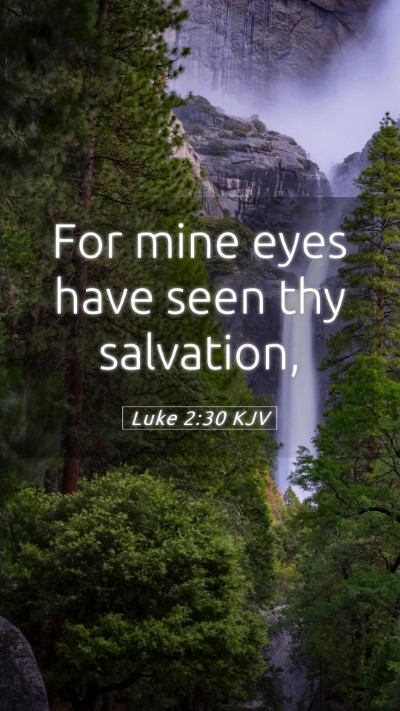Understanding Luke 2:30
Luke 2:30 states: "For mine eyes have seen thy salvation." This verse centers on the profound declaration made by Simeon, a devout man who had been promised by the Holy Spirit that he would not die before seeing the Messiah. Below is a detailed analysis of this scripture, drawing insights from various public domain commentaries.
Bible Verse Meaning
The meaning of Luke 2:30 can be unpacked as follows:
- Recognition of Salvation: Simeon's proclamation exemplifies the recognition of God’s salvation through the arrival of Jesus. It confirms the fulfillment of the promise given to him, showcasing the hope and expectation of Israel finally fulfilled.
- The Significance of Sight: The phrase "mine eyes have seen" emphasizes the importance of eyewitness testimony in the faith journey. For Simeon, seeing Jesus meant witnessing the embodiment of God's promise and His redemptive plan for humanity.
- Messiah’s Arrival: Simeon acknowledges Jesus as the Messiah, which is crucial in understanding the identity of Christ as the Savior of all, not just of Israel. This aligns with the universal scope of the Gospel.
Bible Verse Explanations
According to Matthew Henry's Commentary, Simeon's joy upon seeing Jesus signifies a culmination of religious hope. Henry notes:
"Simeon, having been long waiting for the consolation of Israel, now sees and rejoices in the fulfillment of that promise in his arms."
This reflects on the importance of patience and faith in God’s timing regarding salvation.
Albert Barnes explains that "salvation" refers to deliverance from sin and death, and that Simeon’s statement is not merely about personal salvation, but the salvation to be offered to all. Barnes emphasizes:
"It is a declaration that he has seen the one who will bring salvation to the world."
Adam Clarke adds that Simeon’s encounter with Jesus solidified his hope and resolve. Clarke remarks on the divine nature of the promise received, highlighting that Simeon’s life had real meaning now that he had witnessed the Messiah.
Application of Luke 2:30 to Daily Life
This verse breaks down into several key applications for modern believers:
- Hope in Expectations: Just as Simeon held onto his hope, believers are encouraged to trust in God’s promises, knowing that He is faithful to fulfill them.
- Personal Relationship with Christ: The need for a personal encounter with Jesus is ongoing. Simeon’s joy was based on having an intimate moment with the Savior which is attainable for all believers.
- Sharing the Good News: Having witnessed the joy of salvation, believers are called to share this excitement with others as Simeon did, particularly in their communities and among their circles.
Historical Context and Significance
Understanding the historical context is vital for a deeper comprehension of this verse:
- Cultural Background: In first-century Judea, there was a strong expectation of a messiah who would liberate Israel. Simeon’s encounter signifies that the awaited Messiah arrived not as a political ruler but as a savior for all.
- The Temple as a Symbol: The event takes place in the Temple in Jerusalem, which represents God's presence and the centrality of worship and sacrifice. Simeon’s declaration reinforces the transition from old covenant practices to the new covenant through Christ.
Related Bible Verses
Several Bible verses provide deeper insight and context to Luke 2:30:
- Isaiah 40:5: "And the glory of the Lord shall be revealed, and all flesh shall see it together." - This foreshadows the coming of the Messiah.
- John 1:29: "Behold the Lamb of God, which taketh away the sin of the world." - Affirming the role of Jesus as the savior acknowledged by Simeon.
- Acts 4:12: "Neither is there salvation in any other..." - This emphasizes that salvation comes through Jesus alone, reaffirming Simeon’s declaration.
Conclusion
Luke 2:30 holds deep theological and practical significance, offering a glimpse into the joy of witnessing salvation and encourages believers in their journey of faith. By understanding this verse through historical, cultural, and spiritual lenses, one can appreciate the depth of God's redemptive plan initiated through Christ.


